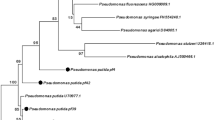Abstract
Sixty-three strains of bacteria capable of utilizing naphthalene as the sole source of carbon and energy were isolated from 137 samples of soil taken in different sites in Belarus. All isolated bacteria contained extrachromosomal genetic elements of 45 to 150 kb in length. It was found that bacteria of 31 strains contained the IncP-9 incompatibility group plasmids, bacteria of one strain carried a plasmid containing replicons IncP-9 and IncP-7, and bacteria of 31 strains contained unidentified plasmids. Primary identification showed that the hosts of plasmids of naphthalene biodegradation are fluorescent bacteria of the genus Pseudomonas (P. putida and P. aeruginosa; a total of 47 strains) and unidentified nonfluorescent microorganisms (a total of 16 strains). In addition to the ability to utilize naphthalene, some strains exhibited the ability to stimulate the growth and development of the root system of Secale cereale.
Similar content being viewed by others
REFERENCES
Boronin, A.M., Rhizosphere Bacteria of the Genus Pseudomonas Facilitating Growth and Development of Bacteria, Sorosovskii Obrazovatel’nyi Zh., 1996, no. 10, pp. 25–31.
Chakrabarty, A.M., Genetic Fusion of Incompatible Plasmids in Pseudomonas, Proc. Natl. Acad. Sci. USA, 1973, vol. 70, no.6, pp. 1641–1644.
Davies, J.I. and Evans, W.C., Oxidative Metabolism of Naphthalene by Soil Pseudomonads. The Ring Fission Metabolism, J. Biochem., 1964, vol. 91, p. 251.
Doudoroff, M. and Palleroni, N.J., Genus Pseudomonas Migula, Buchanan, R.E. and Gibsons, T., Eds., in Bergey’s Manual of Determinative Bacteriology, 8th Ed., Baltimore: The Williams and Wikins Co., 1974, pp. 217–243.
Eckhardt, T., A Rapid Method for the Identification of Plasmid Desoxyribonucleic Acid in Bacteria, Plasmid, 1978, vol. 1, no.4, pp. 584–588.
Evans, C.G.T, Herbert, D, and Tempest, D.M, The Continuous Cultivation of Microorganisms, in Methods in Microbiology, Norris, J.R., Ed., New York: Academic, 1970, pp. 277–327.
Greated, A. and Thomas, C.M., A Pair of PCR Primers for IncP-9 Plasmids, Microbiology, 1999, vol. 145, pp. 3003–3004.
Hansen, J.B. and Olsen, R.H., Isolation of Large Bacterial Plasmids and Characterization of the P2 Incompatibility Group Plasmids PMG1 and PMG5, J. Bacteriol., 1978, vol. 135, no.1, pp. 227–238.
Head, I.M., Bioremediation: Towards a Credible Technology, Microbiology, 1998, vol. 144, pp. 599–608.
Kochetkov, V.V. and Boronin, A.M., Plasmids Involved in Naphthalene Biodegradation That Are Incompatible with the IncP-2 and IncP-7 Group Plasmids, Genetika (Moscow), 1985, vol. 21, no.4, pp. 522–529.
Kochetkov, V.V. and Boronin, A.M., A Comparative Study of Plasmids That Control Biodegradation of Naphthalene by Pseudomonas Culture, Mikrobiologiya, 1984, vol. 53, no.4, pp. 639–644.
Krasowiak, R., Smalla, K., Sokolov, S., Kosheleva, I., Sevastyanovich, Y., Titok, M., and Thomas, C.M., PCR Primers for Detection and Characterisation of IncP-9 Plasmids, FEMS Microbiol. Ecol., 2002, vol. 42, pp. 217–225.
Monticello, D.J., Bakker, D., Schell, M., and Finnerty, W.R., Plasmid-Borne Tn5 Insertion Mutation Resulting in Accumulation of Gentisate from Salicylate, Appl. Environ. Microbiol., 1985, vol. 49, no.4, pp. 761–764.
Mordukhova, E.A., Kochetkov, V.V., Polikarpova, F.Ya., and Boronin, A.M., Synthesis of Indole-3-Acetic Acid by Pseudomonas: The Effect of Plasmids Involved in Naphthalene Biodegradation, Prikl. Biokhim. Mikrobiol., 1998, vol. 34, no.3, pp. 287–292.
Ornston, L.N. and Parke, D., Evolution of Catabolic Pathways, Biochem. Soc. Trans., 1976, vol. 4, no.3, pp. 468–472.
Sambrook, J., Fritsch, E.F., and Maniatis, T., Molecular Cloning: A Laboratory Manual, Cold Spring Harbor, New York: Cold Spring Harbor Lab., 1989.
Yen, K.M. and Gunsalus, I.C., Plasmid Gene Organization: Naphthalene/Salicylate Oxidation, Proc. Natl. Acad. Sci. USA, 1982, vol. 79, no.3, pp. 874–878.
te Riele, H., Michel, B., and Ehrlich, S.D., Single-Stranded Plasmid DNA in Bacillus subtilis and Staphylococcus aureus, Proc. Natl. Acad. Sci. USA, 1979, vol. 8, pp. 2541–2545.
Author information
Authors and Affiliations
Additional information
Translated from Izvestiya Akademii Nauk, Seriya Biologicheskaya, No. 2, 2005, pp. 162–167.
Original Russian Text Copyright © 2005 by Levchuk, Vasilenko, Bulyga, Titok, Thomas.
Rights and permissions
About this article
Cite this article
Levchuk, A.A., Vasilenko, S.L., Bulyga, I.M. et al. Characteristics of natural strains of naphthalene-utilizing bacteria of the genus Pseudomonas . Biol Bull Russ Acad Sci 32, 128–132 (2005). https://doi.org/10.1007/s10525-005-0018-1
Received:
Issue Date:
DOI: https://doi.org/10.1007/s10525-005-0018-1




